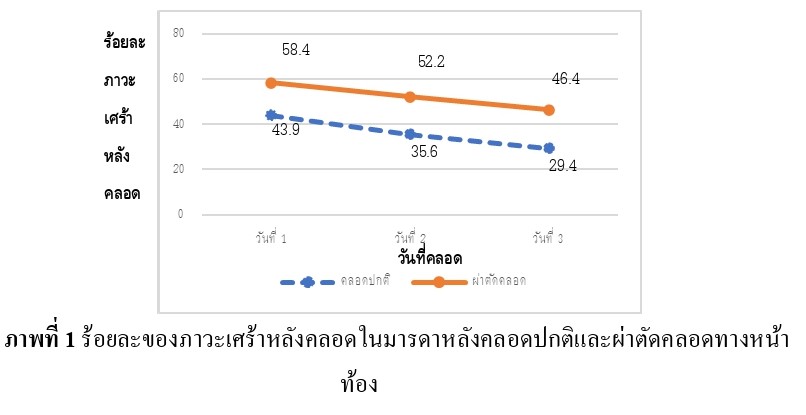Prevalence and Model of postpartum blues among Mother with Normal Labor and Cesarean Section
Rachada Phuangprasonka
Keywords:
Model of postpartum blues, Mother with normal labor, mother with cesarean sectionAbstract
The purpose of this study was to examine the prevalence and pattern of postpartum blues in mothers with normal labor and cesarean sections. 357 samples who experienced postpartum blues after normal labor and cesarean section in the postpartum ward of Samut Prakarn Hospital. The research instruments were a demographic questionnaire and postpartum blues emotion questionnaire of Kennerley and Gath's (1989) which were translated into Thai and then back translated by Phuangprasonka et al. (2016) with a reliability coefficient of 0.79. Data analysis included frequency, percentage, mean, and standard deviation for both demographic data and postpartum blues symptoms. An independent t-test was utilized to compare the postpartum blues score between the groups. Results showed that during the first three days after birth, 43.9% of mothers with normal labor and 58.4% of mothers with cesarean section experienced postpartum blues. The risk of postpartum blues was highest on the first day following delivery and lower in the second - and third-days following delivery in mothers who had normal labor and cesarean section. Between mothers with normal labor and cesarean section, there was a statistically significant difference in the intensity of postpartum blues scores (t = 4.65, p <. 001)
References
Ayuyen, A., Deoisres, W., & Tachasuksri, T. (2020). Prevalence and Pattern of Maternity blues in Postpartum Adolescent Mothers in Hospital. The Journal of Faculty of Nursing Burapha University, 28(4), 1 - 11. https://he02.tci-thaijo.org/index.php/Nubuu/article/view/248240
Beck, C.T., & Driscoll, J.W. (2006). Postpartum mood and anxiety disorder: A clinician guides.
Jones and Bartlett. https://www.amazon.com/Postpartum-Mood-Anxiety-Disorders-Clinici ans/dp/0763716499
Castle, J. (2009). Early detection of postpartum depression: Screening in the first two to three days. The Journal of Lancaster General
Hospital, 3(4), 147 - 150. https://www.jlgh.org/Past-Issues/Volume-3-Issue-4/Early-Detection-of-Postpartum-Depression.aspx
Corwin, E.J., Brownstead, J., Barton, N., Heckard, S., & Morin, K. (2005). The impact of fatigue on the development of postpartum depression. Journal of Obstetric, Gynecologic, & Neonatal Nursing, 34(5), 577 - 586. http://doi.org/10.1177/0884217505279997
Field, T. (2010). Postpartum depression effects on early interactions, parenting, and safety practices: a review. Infant Behavior and Development, 33(1), 1 - 6. http://doi.org/10.1016/j.infbeh.2009 .10.005
Gonidakis, F. (2012). Postpartum depression and maternity blues in immigrants. Perinatal Depression, 117 - 138. http://doi.org/10.5772/30915
Gonidakis, F., Rabavilas, A.D., Varsou, E., Kreatsas, G., & Christodoulou, G.N. (2007). Maternity blues in Athens, Greece: A study during the first 3 days after delivery. Journal of Affective Disorders, 99(1-3), 107 - 115. http://doi.org/10.1016/j.jad.2006.08.028
Hau, F.W., & Levy, V.A. (2003). The maternity blues and Hong Kong Chinese women: an exploratory study. Journal of Affective Disorders, 75(2), 197 - 203. http://doi.org/10.1016/s0165-0327(02) 00039-3
Kennerley, H., & Gath, D. (1989) Maternity blues I: Detection and measurement by questionnaire. British Journal of Psychiatry, 155, 356 - 362. https://pubmed.ncbi. nlm.nih.gov/2611547/
Krejcie, R.V., & Morgan, D.W. (1970). Determining sample size for research activities. Educational and psychological measurement, 30(3), 607 - 610. https://doi.org/10.1177/00131644 7003000308
Kurniawati, D., & Septiyono, E.A. (2022). Determinants of postpartum blues in Indonesia. Pediomaternal Nursing Journal, 8(1). http://dx.doi.org/10.20473/pmnj.v8i1.27649
Lowdermilk, D.L., Perry, S.E., Cashion, K., & Alden, K.R. (2012). Maternity & women’s health care (10th ed.). Elsevier. https://jfklib.oas.psu.ac.th/opac2/BibDetail.aspx? bibno=1151038
Manjunath, N.G., & Venkatesh, G. (2011). Postpartum blue is common in socially and economically insecure mothers. Indian Journal of Community Medicine, 36(3), 231 – 233. http://doi.org /10.4103/0970-0218.86527
O'Hara, M.W., Schlechte, J.A., Lewis, D.A., & Wright, E.J. (1991). Prospective study of postpartum blues: Biologic and psychosocial factors. Archives General Psychiatric, 48(9), 801-806. http://dx.doi.org/10.1001/archpsyc.1991.01810330025004
Phuangprasonka, R., Deoisre, W., & Chunlestskul, K. (2016). Maternity blues and management strategies of Thai postpartum women. Journal of Food Health and Bioenvironmental Science, 11(2), 23 – 27.
Pinchaleaw, D., & Serisathien, Y. (2009). Women’s distress after cesarean section. Journal of Nursing Science (Supplement), 27(2), 28 - 38.
Pinchaleaw, D., & Bhoosahas, P. (2015). Factors related to women’s distress after cesarean section. Journal of The Royal Thai Army Nurses, 16(1), 101-108. https://he01.tci-thaijo.org/index.php/JRTAN/article/view/36165
Rai, S., Pathak, A., & Sharma, I. (2015). Postpartum psychiatric disorders: Early diagnosis and management. Indian Journal of Psychiatry, 57(Suppl. 2), 216 – 221.
Rezaie-Keikhaie, K., Arbabshastan, M. E., Rafiemanesh, H., Amirshahi, M., Ostadkelayeh, S. M., & Arbabisarjou, A. (2020). Systematic review and meta-analysis of the prevalence of the maternity blues in the postpartum period. Journal of Obstetric, Gynecologic & Neonatal Nursing, 49(2), 127 - 136. https://doi.org/10.1016/j.jogn.2020.01.001
Sarah, S. B., Forozan, S. P., & Leila, D. (2017). The relationship between model of delivery and postpartum depression. Annals of Tropical Medicine & Public Health, 10(4), 874 – 877. https://www.cabidigitallibrary.org/doi/full/10.5555/20183153844
Takahashi, Y. & Tamakoshi, K. (2014). Factors associated with early postpartum maternity blues and depression tendency among Japanese mothers with full-term healthy infants. Nagoya journal of medical science, 76(1-2), 129 – 138. https://www.researchgate.net/ publication/264867289 _Factors_associated_with_early_postpartum_maternity_blues_and_depression_tendency_among_Japanese_ mothers_with_full-term_healthy_infants
Thurgood, S., Avery, D. M., & Williamson, L. (2009). Postpartum depression (PPD). American Journal of Clinical Medicine, 6(2), 17 - 22. https://www.aapsus.org/wp-content/uploads/ Postpartum-Depression.pdf
Wong, D.L., Perry, S.E., Hockenberry, M.J., & Lowdermilk, D. L., & Wilson, D. (2006). Maternal child nursing care. (3rd ed.). Mosby-Year Book.
Yokote, N. (2008). Women’s experiences of labor, surgery and first postnatal week by an emergency cesarean section. Journal of Japan Academy of Midwifery, 22(1), 37 - 48. https://www.jstage. jst.go.jp/article/jjam/22/1/22_1_37/_pdf

Downloads
Published
How to Cite
Issue
Section
License
Copyright (c) 2024 Princess of Naradhiwas University Journal

This work is licensed under a Creative Commons Attribution-NonCommercial-NoDerivatives 4.0 International License.



